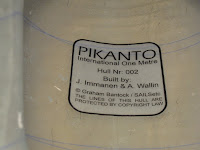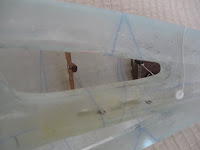After sailing a Triple Crown for over five years (with mixed results) it's time for a new and better designed boat. Click here to see the building of that old boat.
We had initially a lot of designs to pick from, but we chose a modern, Graham Bantock designed, Pikanto-model.
This time we didn't build it all from scratch, we got the hull from the factory of Immanen & Wallin in Helsinki. We hope to trick it out and optimize its performance and handling. This post will be updated during winter and spring of 2010. Stay tuned!







































February 18th





July 29th

Side view.
Pikanto, deck view.
One picture, 24 words.
Backstay attachments as far astern as possible.
Looking forward inside the hull.
Viewing astern inside the hull.
Sheet turning block in the bow.
Sheet turning block from the inside and close-up.
Turning block for the jib sheet.
February 20th
The push-pull rudder-post. A block for a rubber band can be
attached to one of the holes.
Making it even sturdier.
February 21st
Supporting beams give extra strength to the fin box. The frame-timber is 0,8 mm mahogany coated on both sides with glassfiber. The result should be extra strength at minimal weight costs.
This keel will definitely not be a swingkeel.
February 24th
Mainsheet post.
No lines or sheets on deck.
February 25th
Fairlead for mainsheet and rubber band.
February 26th
The bar between the mainsheet post and keeltrunk
supports the radioplate.
February 27th
Servo tray; 3mm mahogany veneer coated on both sides with glassfiber and
epoxy glue, weight about 20 grams.
March 1st
Carbon arm on an aluminium servo horn. The servos are firmly attached.
The powerhouse Hitec HS-7950: 7.2 V » 35 kg/cm
March 3rd
Servo tray anchored even to the topsides.
March 6th
Port side of the servo tray is for batteries and receiver that will be placed in small bags.
March 7th
Eyebolt for rigging screw.
The topsides are extra reinforced down to the keeltrunk with glassfiber.
A 50 mm long oakpiece holds the screw in place.
March 10th
Headsail swivel line.
The line starts from a ball bearing swivel fastened
to a glassfiber coated piece of veneer
March 21st

The two pins are for no. 2 and 3 jib pivots
No. 3 jib pivot and foredeck secured with a
stainless steelstay to the bottom.
April 1st

Mast locking wheel
April 3rd

Foredeck patches
April 5th

Deck patches. Note that the boat has turned white (undercoat).
April 10th

A natural mast partner. The boat has been painted with International
Perfection (2-component polyurethane paint) Off White Nr 192.
July 29th

Rudder servo arrangement.
May 30th (2011)

The left screw is for bulb cant adjustment.

The left screw is for bulb cant adjustment.

Winch arm system. Servo Hitec HS-7950, very strong and extremly fast.

Ready for sail.

Christening.

Happy faces.
Sailing.
She sailed well.





























No comments:
Post a Comment